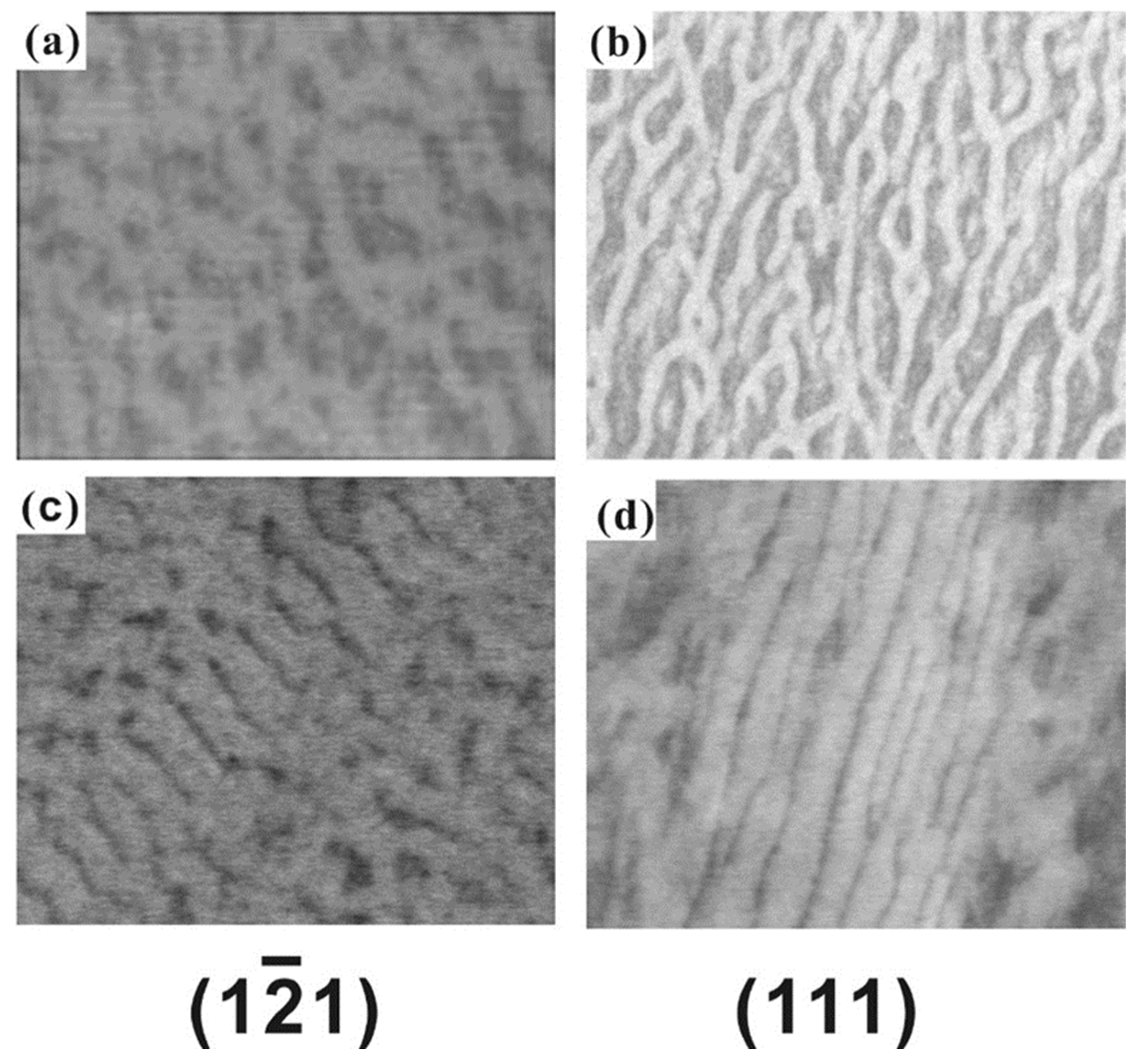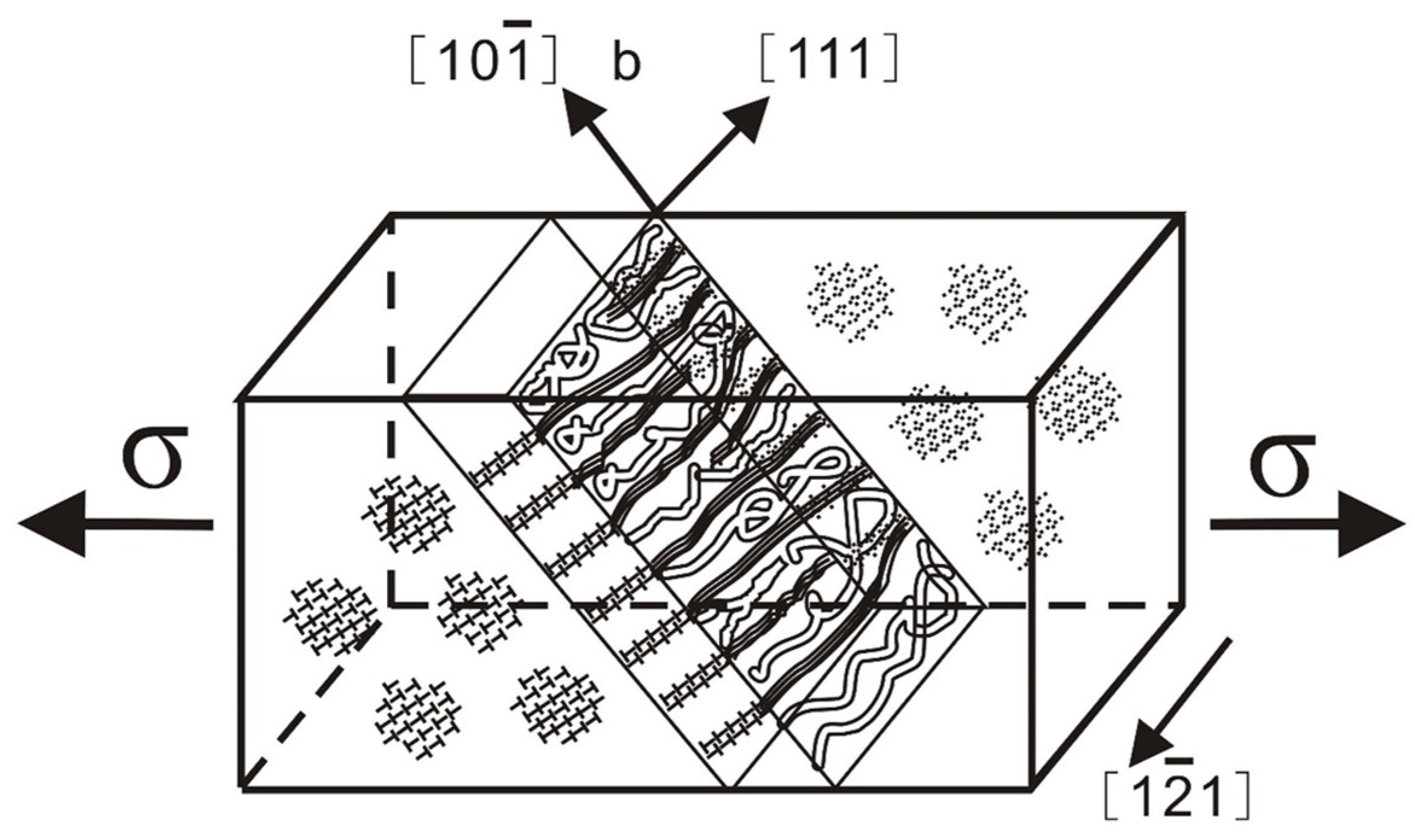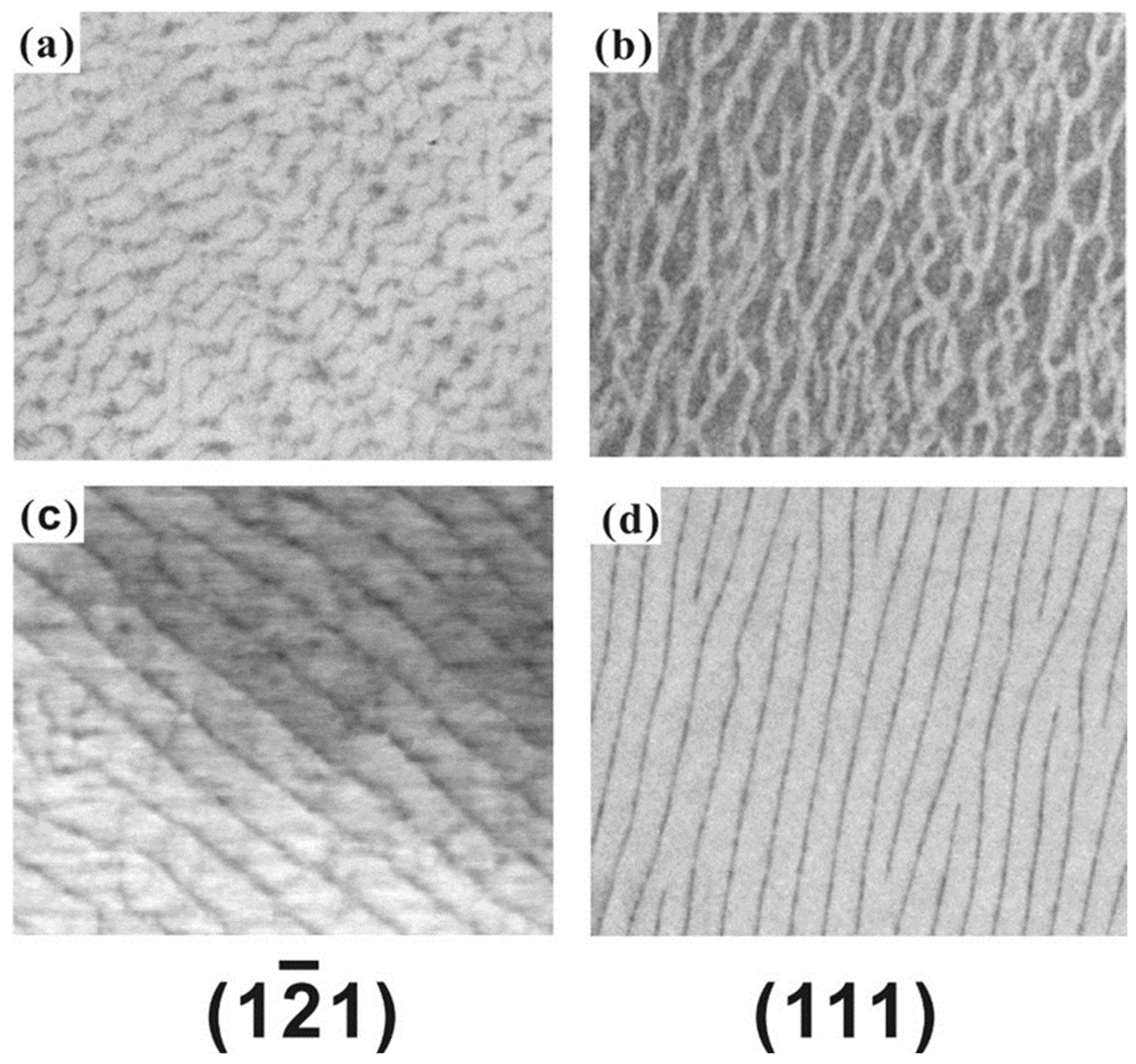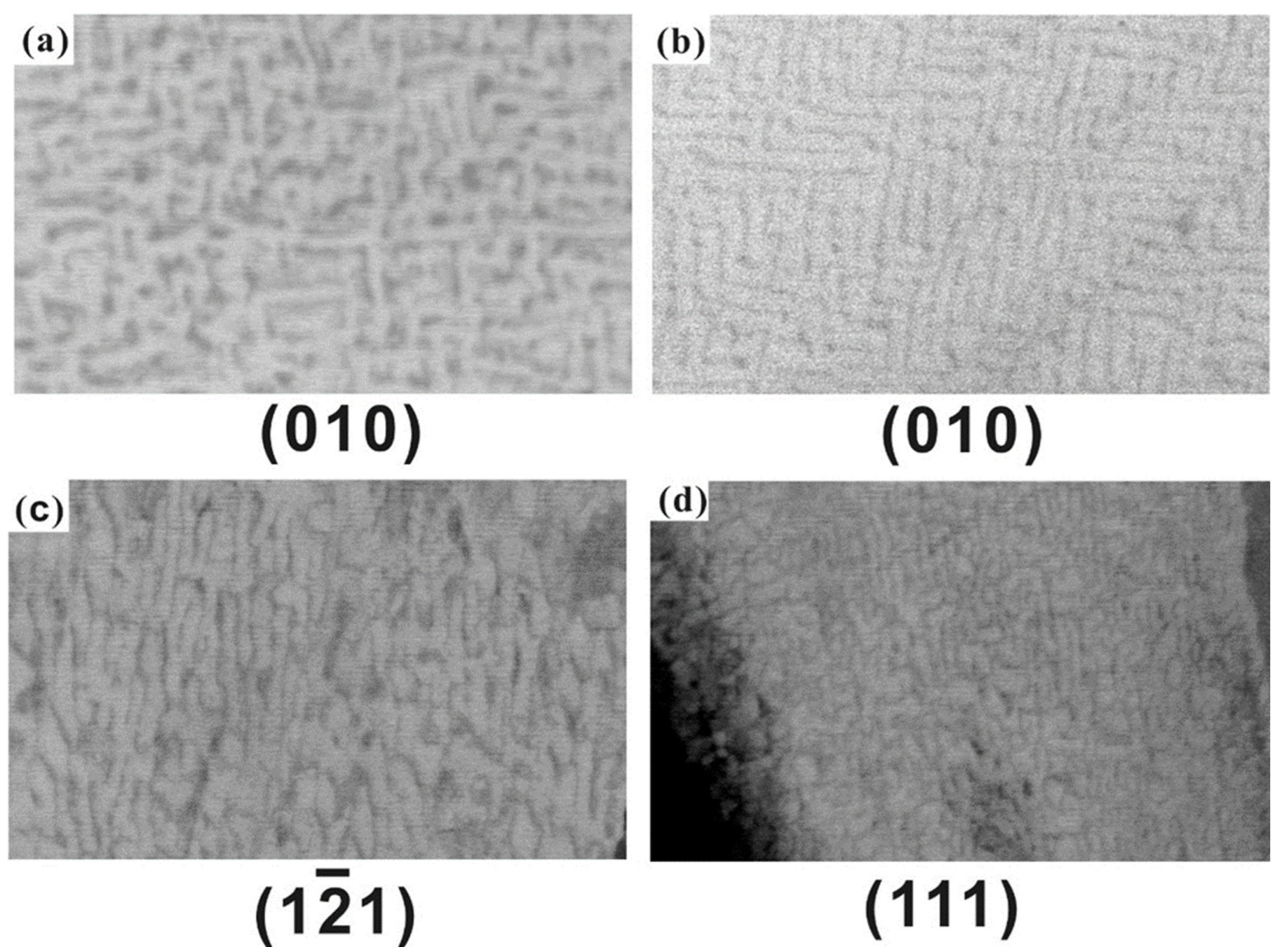Comparison on Hysteresis Loops and Dislocation Configurations in Fatigued Face-Centered Cubic Single Crystals
Abstract
1. Introduction
2. Experimental Procedures
3. Results and Discussion
3.1. Comparison on Hysteresis Loops of FCC Single Crystals with Various Orientations
3.2. Comparison between Dislocation Configurations: Patch vs. Vein and Ladder vs. Wall
3.3. Comparison between Wall Structures: Line Wall vs. Point Wall
3.4. Relationship between Dislocation Configurations: Vein vs. Wall and Labyrinth vs. Cell
4. Conclusions
- The hysteresis loops of and Cu single crystals exhibit obvious cyclic hardening, while the hysteresis loops of and Cu single crystals show cyclic saturation. Additionally, the Bauschinger effect of Cu single crystals also exhibits orientation dependence.
- Dislocation ladder and wall structure, as well as patch and vein structure, belong to their respective observation planes, and , which correspond to point defects and line defects of dislocations, respectively.
- The wall structures on the and planes are derived from the evolution of different dislocation configurations. This is because DBII, composed of wall structures, is prone to occur in -oriented crystals. Due to having the largest angle between and in the stereographic triangles, only DBII with a habit plane can obtain the maximum nucleation driving force.
- The change in dislocation density between the vein and the wall indicates that the wall structure is the result of the evolution of the veins, with dislocation-intensive areas becoming further compressed. The formation of labyrinth and cell structures implies the activation of different slip systems. In summary, the dislocation configuration is a three-dimensional structure, with each section observed on different planes representing only a part of the whole structure.
Author Contributions
Funding
Data Availability Statement
Acknowledgments
Conflicts of Interest
References
- Thompson, N.B.W.; Wadsworth, N.J.; Louat, N. The origin of fatigue fracture in copper. Philos. Mag. 1956, 1, 113–126. [Google Scholar] [CrossRef]
- Li, P.; Kong, L.W.; Zhang, Z.X.; Zhao, J.; Du, C.C.; Huang, J.Y.; Zhang, Z.F. In-situ TEM investigation of structural transformation from LEDS to twin in fatigued Cu single crystal during annealing. Philos. Mag. 2020, 100, 3070–3091. [Google Scholar] [CrossRef]
- Yang, H.; Zhu, L.; Zhang, R.; Zhou, J.; Sun, Z. Shearing dominated by the coupling of the interfacial misfit and atomic bonding at the FCC (111) semi-coherent interfaces. Mater. Design 2020, 186, 108294. [Google Scholar] [CrossRef]
- Lavenstein, S.; Gu, Y.; Madisetti, D.; El-Awady, J.A. The heterogeneity of persistent slip band nucleation and evolution in metals at the micrometer scale. Science 2020, 370, eabb2690. [Google Scholar] [CrossRef] [PubMed]
- Meng, F.; Ferrié, E.; Déprés, C.; Fivel, M. 3D discrete dislocation dynamic investigations of persistent slip band formation in FCC metals under cyclical deformation. Int. J. Fatigue 2021, 149, 106234. [Google Scholar] [CrossRef]
- Wang, X.; Zhao, Y.; Wang, L.; Wei, L.; He, J.; Guan, X. In-situ SEM investigation and modeling of small crack growth behavior of additively manufactured titanium alloy. Int. J. Fatigue 2021, 149, 106303. [Google Scholar] [CrossRef]
- Dodaran, M.S.; Muhammad, M.; Shamsaei, N.; Shao, S. Synergistic effect of microstructure and defects on the initiation of fatigue cracks in additively manufactured Inconel 718. Int. J. Fatigue 2022, 162, 107002. [Google Scholar] [CrossRef]
- Polák, J. Role of Persistent Slip Bands and Persistent Slip Markings in Fatigue Crack Initiation in Polycrystals. Crystals 2023, 13, 220. [Google Scholar] [CrossRef]
- Babinský, T.; Kuběna, I.; Šulák, I.; Kruml, T.; Tobiáš, J.; Polák, J. Surface relief evolution and fatigue crack initiation in René 41 superalloy cycled at room temperature. Mater. Sci. Eng. A 2021, 819, 141520. [Google Scholar] [CrossRef]
- Polák, J.; Man, J.; Kruml, T. The sources of cyclic slip irreversibility. Acta Mater. 2024, 267, 119709. [Google Scholar] [CrossRef]
- Mughrabi, H. The cyclic hardening and saturation behaviour of copper single crystals. Mat. Sci. Eng. 1978, 33, 207–223. [Google Scholar] [CrossRef]
- Winter, A.T. A model for the fatigue of copper at low plastic strain amplitudes. Philos. Mag. A J. Theor. Exp. Appl. Phys. 1974, 30, 719–738. [Google Scholar] [CrossRef]
- Zhang, Z.F.; Wang, Z.G.; Sun, Z.M. Evolution and microstructural characteristics of deformation bands in fatigued copper single crystals. Acta Mater. 2001, 49, 2875–2886. [Google Scholar] [CrossRef]
- Loretto, M.H. Dislocations and Properties of Real Materials; The Institute of Metals: London, UK, 1985. [Google Scholar]
- Fujii, T.; Kajita, T.; Miyazawa, T.; Arai, S. Characterization of dislocation microstructures in cyclically deformed [001] copper single crystals using high voltage scanning transmission electron microscopy. Mater. Charact. 2018, 136, 206–211. [Google Scholar] [CrossRef]
- Lepinoux, J.; Kubin, L.P. In situ TEM observations of the cyclic dislocation behaviour in persistent slip bands of copper single crystals. Philos. Mag. A 1985, 51, 675–696. [Google Scholar] [CrossRef]
- Laird, C.; Wang, Z.; Ma, B.T.; Chai, H.F. Low energy dislocation structures produced by cyclic softening. Mater. Sci. Eng. A 1989, 113, 245–257. [Google Scholar] [CrossRef]
- Zauter, R.; Petry, F.; Bayerlein, M.; Sommer, C.; Christ, H.J.; Mughrabi, H. Electron channelling contrast as a supplementary method for microstructural investigations in deformed metals. Philos. Mag. A 1992, 66, 425–436. [Google Scholar] [CrossRef]
- Schwab, A.; Bretschneider, J.; Buque, C.; Blochwitz, C.; Holste, C. Application of electron channelling contrast to the investigation of strain localization effects in cyclically deformed fcc crystals. Phil. Mag. Lett. 1996, 74, 449–454. [Google Scholar] [CrossRef]
- Melisova, D.; Weiss, B.; Stickler, R. Nucleation of persistent slip bands in Cu single crystals under stress controlled cycling. Scripta Mater. 1997, 36, 1061–1066. [Google Scholar] [CrossRef]
- Ahmed, J.; Wilkinson, A.J.; Roberts, S.G. Electron channelling contrast imaging characterization of dislocation structures associated with extrusion and intrusion systems and fatigue cracks in copper single crystals. Philos. Mag. A 2001, 81, 1473–1488. [Google Scholar] [CrossRef]
- Zhang, Z.F.; Wang, Z.G. Investigations of dislocation patterns within grains and near grain boundaries in copper by the electron channelling contrast technique in scanning electron microscopy. Phil. Mag. Lett. 1998, 78, 105–113. [Google Scholar] [CrossRef]
- Zhang, Z.F.; Wang, Z.G.; Hu, Y.M. Effects of grain boundary on slip morphology and dislocation patterns in a fatigued copper bicrystal. Scripta Mater. 1999, 40, 1353–1358. [Google Scholar] [CrossRef]
- Zhang, Z.F.; Wang, Z.G. Dependence of intergranular fatigue cracking on the interactions of persistent slip bands with grain boundaries. Acta Mater. 2003, 51, 347–364. [Google Scholar] [CrossRef]
- Li, S.X.; Li, X.W.; Zhang, Z.F.; Wang, Z.G.; Lu, K. On the formation of deformation bands in fatigued copper single crystals. Philos. Mag. A 2002, 82, 3129–3147. [Google Scholar] [CrossRef]
- Vermeij, T.; Peerlings, R.H.J.; Geers, M.G.D.; Hoefnagels, J.P.M. Automated identification of slip system activity fields from digital image correlation data. Acta Mater. 2023, 243, 118502. [Google Scholar] [CrossRef]
- Kaneko, Y.; Ishikawa, N.; Vinogradov, A.; Kitagawa, K. Hysteresis Loop Shape of a Cyclically-Deformed Copper Tricrystal Having Two Longitudinal Grain Boundaries. Scripta Mater. 1998, 38, 1609–1614. [Google Scholar] [CrossRef]
- Wang, Q.; Wang, Q.; Gong, X.; Wang, T.; Zhang, W.; Li, L.; Liu, Y.; He, C.; Wang, C.; Zhang, H. A comparative study of low cycle fatigue behavior and microstructure of Cr-based steel at room and high temperatures. Mater. Design 2020, 195, 109000. [Google Scholar] [CrossRef]
- Hou, J.P.; Wang, Q.; Zhang, Z.J.; Tian, Y.Z.; Wu, X.M.; Yang, H.J.; Li, X.W.; Zhang, Z.F. Nano-scale precipitates: The key to high strength and high conductivity in Al alloy wire. Mater. Design 2017, 132, 148–157. [Google Scholar] [CrossRef]








Disclaimer/Publisher’s Note: The statements, opinions and data contained in all publications are solely those of the individual author(s) and contributor(s) and not of MDPI and/or the editor(s). MDPI and/or the editor(s) disclaim responsibility for any injury to people or property resulting from any ideas, methods, instructions or products referred to in the content. |
© 2024 by the authors. Licensee MDPI, Basel, Switzerland. This article is an open access article distributed under the terms and conditions of the Creative Commons Attribution (CC BY) license (https://creativecommons.org/licenses/by/4.0/).
Share and Cite
Xing, Z.; Kong, L.; Pang, L.; Liu, X.; Ma, K.; Wu, W.; Li, P. Comparison on Hysteresis Loops and Dislocation Configurations in Fatigued Face-Centered Cubic Single Crystals. Metals 2024, 14, 1023. https://doi.org/10.3390/met14091023
Xing Z, Kong L, Pang L, Liu X, Ma K, Wu W, Li P. Comparison on Hysteresis Loops and Dislocation Configurations in Fatigued Face-Centered Cubic Single Crystals. Metals. 2024; 14(9):1023. https://doi.org/10.3390/met14091023
Chicago/Turabian StyleXing, Zhibin, Lingwei Kong, Lei Pang, Xu Liu, Kunyang Ma, Wenbo Wu, and Peng Li. 2024. "Comparison on Hysteresis Loops and Dislocation Configurations in Fatigued Face-Centered Cubic Single Crystals" Metals 14, no. 9: 1023. https://doi.org/10.3390/met14091023
APA StyleXing, Z., Kong, L., Pang, L., Liu, X., Ma, K., Wu, W., & Li, P. (2024). Comparison on Hysteresis Loops and Dislocation Configurations in Fatigued Face-Centered Cubic Single Crystals. Metals, 14(9), 1023. https://doi.org/10.3390/met14091023



